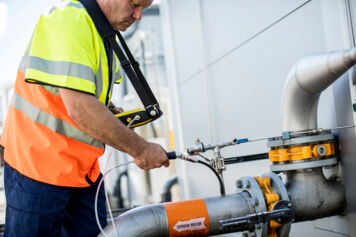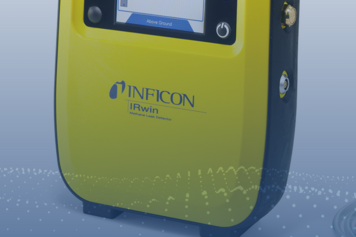Greenhouse Gases, Net-Zero Goals, and the Role of Biomethane
Using biomethane as an alternative to fossil-fuel-sourced natural gas.
Greenhouse gases (GHG) such as carbon dioxide, methane, ozone, nitrous oxide, and water vapor help regulate the Earth’s temperature through a process known as the Greenhouse Effect.
In the last century, however, human activities—especially from burning fossil fuels like coal, oil, and gas—have led to the release of excess carbon dioxide and other greenhouse gases into the atmosphere. This is causing the planet’s temperature to rise and altering long-term weather patterns or climate change.
Across industries, companies are implementing measures to cut greenhouse gas emissions and move closer to net-zero targets, from installing green-energy systems to adopting renewable sources of natural gas such as biogas and biomethane.

INFICON technology is supporting these efforts through its analytical solutions being used along the value chain—whether through advanced gas leak detection or analysis of biogas and biomethane—to help protect the environment while advancing sustainability goals.
A Potent but Overlooked Greenhouse Gas
Many facilities in cold climates often utilize natural gas for heating. Unfortunately, natural gas primarily consists of methane, which is more potent than carbon dioxide (CO2). Even though methane has considerably shorter residence time in the atmosphere (10 years compared to the hundreds of years for CO2), when measured over a 20-year period, methane is more than 80 times more potent than CO2 and 20 times more potent when measured over 100 years.
While emissions from burning natural gas are lower than those from coal or oil, they are much higher than those from clean energy sources. The drilling, extraction, and transportation processes all contribute to high methane leakage, as confirmed by field and aerial studies.


But the cost to change infrastructure can be prohibitive. A possible solution is to move the source from fossil-fuel-based to biomethane produced from anaerobic decomposition of organic matter. This approach prevents the release of methane that would otherwise be wasted. The gas is captured and utilized from fugitive methane emissions from sources such as landfills, manure lagoons, and wastewater treatment, leading to a reduction in these gases released into the atmosphere and reducing the need for drilling for natural gas.
Biogas is transformed into biomethane by separating methane from carbon dioxide, hydrogen sulfide, and water vapor, which can then be used as a direct replacement for natural gas without any infrastructure changes. Gas analyzers quantify the components and provide the calorific value of the gas.
Solutions from INFICON
Analytical solutions from INFICON are helping organizations meet net-zero emissions goals through leak detection and gas analysis.
Our IRwin® Methane Leak Detector offers a cost-efficient solution to detect leaks in landfills, wastewater treatment plants, anaerobic digesters at agricultural and industrial facilities, oil and gas facilities, and pipelines. Intrinsically safe, the IRwin Methane Leak Detector is an intuitive, robust, and fast instrument specially developed for demanding applications where methane leaks need to be identified and pinpointed. The instrument uses proprietary IR technology to measure methane concentrations from the ppm range up to 100 vol%. This technology also offers an instrument that is selective to methane and recovers quickly after significant gas exposure. Fast response and recovery times, no cross-sensitivity, efficient accessories, and digitalized documentation are key features for a quicker leak survey routine.


Once the leaks are identified and the biogas is captured, it must be purified to become biomethane, making gas analysis critical. The quality of the purified gas must be measured so that it can be mixed and transported with natural gas. Gas chromatography is a well-known analytical technique used to separate and quantify gases. Our Micro GC Fusion differs from traditional chromatography because it offers fast analysis in a transportable chassis. Micro GCs can be taken into the field for rapid on-site gas analysis while maintaining sample integrity in harsh environments, such as landfills. Alternatively, the Micro GC can be set up in a fixed location, and its small footprint is optimal for limited space conditions. The Micro GC Fusion is equipped with a microelectromechanical systems (MEMS) micro Thermal Conductivity Detector (TCD) that offers a 1 ppm detection limit, which is at least 10 times more sensitive than traditional TCD.


Global Production and Use of Biomethane
Using biomethane as an alternative to fossil-fuel-based natural gas is not a quick solution, largely due to limits on supply and infrastructure. Europe is currently the largest producer of biogas, with Germany accounting for nearly two-thirds of Europe’s biogas plant capacity. While energy crops initially fueled Germany’s biogas expansion, policy has shift toward using crop residues, sequential crops, livestock waste, and methane captured from landfills. Other European countries, including Denmark, France, Italy, and the Netherlands, also promote biogas production.
In China, biogas policies historically supported household use, with industrial-scale biomethane adoption only beginning more recently. In the United States, nearly 90% of biogas production comes from landfill gas collection. There is also growing interest in biogas production from agricultural waste as a feedstock, with livestock responsible for roughly one-third of U.S. methane emissions. Several new plants have recently opened near our Syracuse, N.Y., facility, highlighting this shift. The U.S. is also a global leader in using biomethane as a transport fuel, supported by both state and federal incentives.
Driven by the need for sustainable energy, necessity to reduce GHG emissions, advances in technology, and economies of scale, biomethane is poised to become increasingly accessible and cost-effective, making it a viable tool in organizations’ paths toward environmentally sustainable operations.
Want to Learn More about our Innovative Solutions for Leak Detection and Gas Analysis?
Our newsletter offers regular updates on our latest products, applications, upcoming events, and other interesting news.
Read more

Discover how biogas from waste can be turned into clean energy with help from fast, on-site gas analysis using Micro GC technology from INFICON.

As industries seek better industrial emissions management, using a modern LDAR tool can deliver measurable environmental and compliance benefits.

By Efficiently Identifying and Eliminating Methane Leaks

